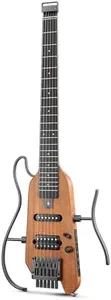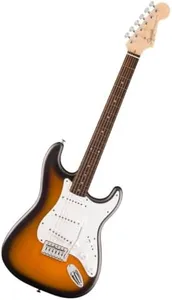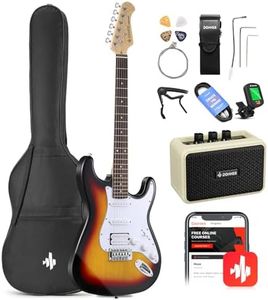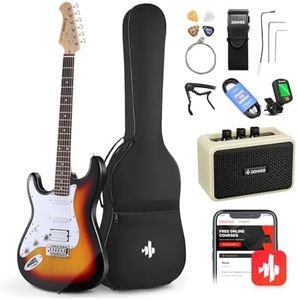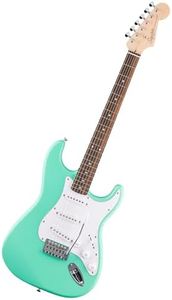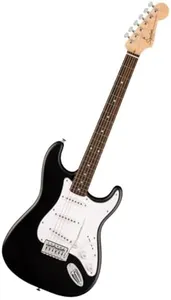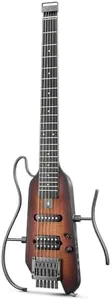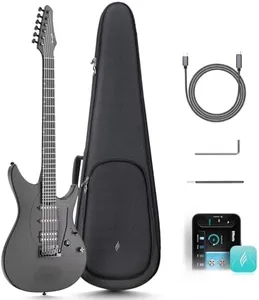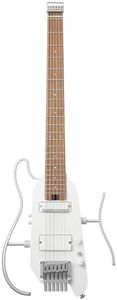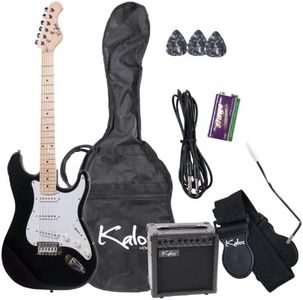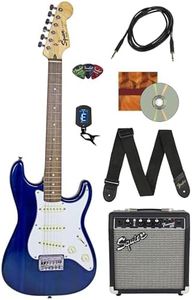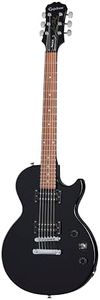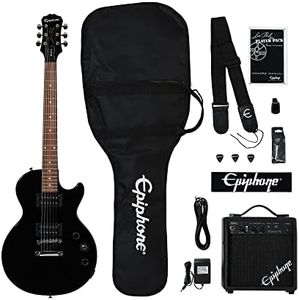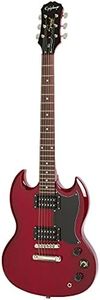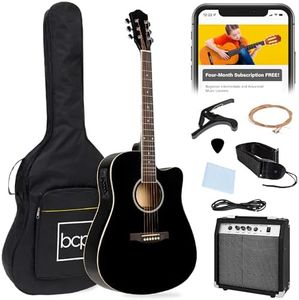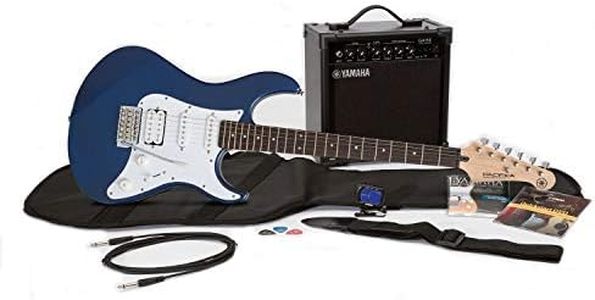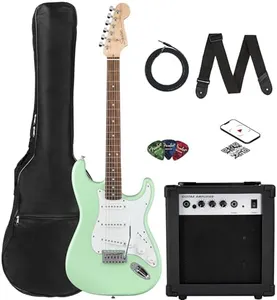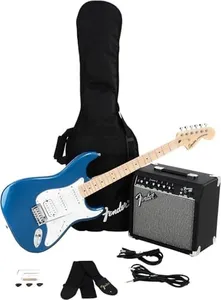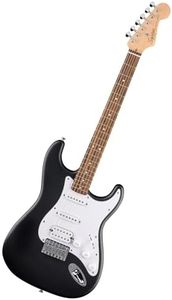10 Best Beginner Electric Guitars 2025 in the United States
Our technology thoroughly searches through the online shopping world, reviewing hundreds of sites. We then process and analyze this information, updating in real-time to bring you the latest top-rated products. This way, you always get the best and most current options available.

Our Top Picks
Winner
Fender Squier Debut Series Stratocaster Electric Guitar, Beginner Guitar, with 2-Year Warranty, Includes Free Lessons, 2-Color Sunburst with Matte Finish
Most important from
1086 reviews
The Fender Squier Debut Series Stratocaster Electric Guitar is tailored for beginners of all ages. With its lightweight poplar body and a comfortable 'C' shaped neck made from maple, this guitar promises ease of playability, which is crucial for those just starting out. The 25.5-inch scale length is standard for Stratocasters and helps maintain familiar playability and tone.
Equipped with three single-coil pickups and a 5-way switch, it offers a versatile range of classic Stratocaster tones, allowing beginners to explore various soundscapes. The inclusion of a tremolo bridge with a removable arm adds an extra layer of fun with string bending effects, which can be exciting for new players experimenting with different techniques. An added bonus is the subscription to Fender Play, which provides thousands of instructional videos to help build skills through songs that users might already love, encouraging consistent practice without additional costs.
On the downside, at roughly 9.92 pounds, the guitar might feel a bit heavy for younger players or those who prefer a lighter instrument. The laurel fingerboard, while functional, may not offer the same smooth feel as more premium woods like rosewood. Additionally, being an entry-level guitar, it may lack some of the more refined features and build quality seen in higher-end models. However, for its price point and the added value of lessons, it's a strong contender for anyone starting their musical journey.
Most important from
1086 reviews
Donner DST-100S 39 Inch Full Size Electric Guitar Kit Solid Body Sunburst, Beginner Starter, with Amplifier, Bag, Capo, Strap, String, Tuner, Cable, Picks
Most important from
6179 reviews
The Donner DST-100S 39 Inch Full Size Electric Guitar Kit is an appealing choice for beginners. The guitar features a solid poplar body, which is durable and produces a good sound. It is equipped with a combination of two Single-coil pickups and one Humbucker pickup (H-S-S configuration), offering versatile sound options suitable for various musical styles, including Texas blues/rock.
The Canadian maple neck with a comfortable 'C' shaped profile and purpleheart fingerboard makes it easy to play, even for those just starting out. The guitar features 22 copper-nickel frets with position marks, aiding in learning and finger placement, which is particularly helpful for beginners. The included portable mini amplifier is a great addition, allowing users to start playing right away. It has two-tone channels and a headphone jack for silent practice, ideal for those who want to practice without disturbing others.
The kit includes essential accessories such as a bag, capo, strap, extra strings, digital tuner, amp cable, and picks, making it a comprehensive starter pack. At 14.26 pounds, it is relatively light, which makes it easier to handle for prolonged playing sessions. On the downside, while the portable amplifier is convenient, it may not offer the highest quality sound compared to more expensive models. Additionally, the guitar's single swing bridge may require frequent adjustments to keep the instrument in tune. Despite these minor drawbacks, the Donner DST-100S provides a solid introduction to electric guitar playing with everything a beginner needs to start their musical journey.
Most important from
6179 reviews
Donner 39 Inch Left-Handed Electric Guitar Kit Solid Body Sunburst Lefty Beginner Set Full-Size with Amplifier Online Lesson Bag Digital Tuner Capo Strap String Cable Picks DST-100SL
Most important from
6179 reviews
The Donner 39 Inch Left-Handed Electric Guitar Kit is an excellent choice for beginners, offering a comprehensive package that includes everything needed to start playing right away. The guitar features a solid poplar body in a sunburst finish, which not only looks appealing but also provides durability. The Canadian maple neck with a 'C' shaped profile and purpleheart fingerboard offer a comfortable playing experience, ideal for beginners still developing their skills.
Its H-S-S pickup configuration, with two single-coil pickups and one humbucker, allows for versatile sound options, catering to various music styles from blues to rock. The five-way pickup switch and tone/volume controls further enhance its adaptability. Additionally, the guitar has 22 copper-nickel frets with clear position markers, making it easier to navigate the fretboard.
The kit's inclusion of a rechargeable mini amplifier with clean and distortion channels is a practical addition, providing flexibility in sound output and ease of use. Other accessories like a bag, digital tuner, capo, strap, strings, cable, and picks ensure that beginners have all the necessary tools to start their musical journey. At 14.34 pounds, it might be slightly heavy for younger players or those looking for a lightweight option. The nickel-plated strings and single swing bridge system are standard but might require occasional adjustments to maintain optimal performance.
Most important from
6179 reviews
Buying Guide for the Best Beginner Electric Guitars
Choosing a beginner electric guitar can be an exciting yet overwhelming experience. The right guitar can make learning more enjoyable and help you progress faster. When selecting a beginner electric guitar, it's important to consider several key specifications that will impact your playing experience. Understanding these specs will help you make an informed decision and find the best fit for your needs.FAQ
Most Popular Categories Right Now
